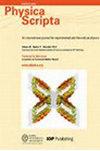研究马氏体相变温度和居里温差对掺硅 Ni-Mn-In Heusler 合金在低磁场下的磁性和磁致性的影响
IF 2.6
3区 物理与天体物理
Q2 PHYSICS, MULTIDISCIPLINARY
引用次数: 0
摘要
本研究探讨了用 Si 代替 Mn 对 Ni43Mn46-xSixIn11 (x = 0.3 和 0.6)合金的结构、磁性和磁致性的影响。为此,我们采用了一系列分析技术,包括扫描电子显微镜 (SEM)、室温 X 射线粉末衍射 (XRD) 和磁化测量。在马氏体转变温度以上,Ni43Mn46-xSixIn11 合金呈现立方 L21(空间群 FM-3M)。在此温度以下,它们采用四方 L10(空间群 I4/mmm)。当 Si 取代 Mn 时,马氏体转变温度降低。磁场诱导的熵变是利用麦克斯韦方程通过磁场磁化测量计算得出的。在磁场变化为 18 kOe 时,Ni43.16Mn45.56Si0.29In11 和 Ni43.51Mn44.82Si0.59In11 合金在磁结构相变附近的最大磁场诱导熵变化分别为 8.20 J kg-1K-1 和 3.15 J kg-1 K-1。研究表明,高温奥氏体相居里点 (TC) 与平均马氏体转变温度 (TM) 之间的温差,即 (TM-TC) 会影响马氏体转变温度,进而影响磁场诱导的熵变 (ΔSM)。本文章由计算机程序翻译,如有差异,请以英文原文为准。
Investigation of the effect of martensitic phase transition temperature and Curie temperature difference on magnetic and magnetocaloric properties under low magnetic field on Si-doped Ni-Mn-In Heusler alloys
This study examines the impact of substituting Si for Mn on the structural, magnetic, and magnetocaloric properties of Ni43Mn46−xSixIn11 (x = 0.3 and 0.6) alloys. To this end, a range of analytical techniques are employed, including scanning electron microscopy (SEM), room temperature x-ray powder diffraction (XRD), and magnetization measurements. Above the martensitic transition temperature, the Ni43Mn46−xSixIn11 alloys exhibit cubic L21 (space group FM-3M). Below this temperature they adopt a tetragonal L10 (space group I4/mmm). The martensitic transition temperature decreased when Si is substituted for Mn. The magnetic field-induced entropy change is calculated from magnetic field-dependent magnetization measurements using Maxwell’s equations. The maximum magnetic field-induced entropy changes for Ni43.16Mn45.56Si0.29In11 and Ni43.51Mn44.82Si0.59In11 alloys are calculated 8.20 J kg−1K−1 and 3.15 J kg−1 K−1, respectively, in the vicinity of the magnetostructural phase transition for a magnetic field change of 18 kOe. It is demonstrated that the temperature differential between the high-temperature austenite phase's Curie point (TC) and the mean martensitic transformation temperature (TM), namely (TM-TC), influences the martensitic transition temperatures and, consequently, on the magnetic field-induced entropy change (ΔSM).
求助全文
通过发布文献求助,成功后即可免费获取论文全文。
去求助
来源期刊

Physica Scripta
物理-物理:综合
CiteScore
3.70
自引率
3.40%
发文量
782
审稿时长
4.5 months
期刊介绍:
Physica Scripta is an international journal for original research in any branch of experimental and theoretical physics. Articles will be considered in any of the following topics, and interdisciplinary topics involving physics are also welcomed:
-Atomic, molecular and optical physics-
Plasma physics-
Condensed matter physics-
Mathematical physics-
Astrophysics-
High energy physics-
Nuclear physics-
Nonlinear physics.
The journal aims to increase the visibility and accessibility of research to the wider physical sciences community. Articles on topics of broad interest are encouraged and submissions in more specialist fields should endeavour to include reference to the wider context of their research in the introduction.
 求助内容:
求助内容: 应助结果提醒方式:
应助结果提醒方式:


